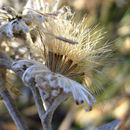Comments
(
Inglês
)
fornecido por eFloras
Hazardia cana is known from San Clemente Island.
- licença
- cc-by-nc-sa-3.0
- direitos autorais
- Missouri Botanical Garden, 4344 Shaw Boulevard, St. Louis, MO, 63110 USA
Description
(
Inglês
)
fornecido por eFloras
Shrubs, 60–250 cm. Stems lanate-tomentose. Leaves subsessile or subpetiolate; blades oblanceolate, 4–12 × 1–4 cm, thin, bases not clasping, margins serrulate to subentire, abaxial faces densely short-tomentose, adaxial glabrate or glabrescent. Heads in thyrsiform arrays. Involucres broadly turbinate, 7–10 × 5–8 mm. Phyllaries erect, oblong, apices acute, faces of outer loosely woolly-tufted apically. Ray florets 6–14, fertile; corollas shorter than involucre, inconspicuous. Disc florets 15–25; corollas 5–8 mm. Cypselae 3–4 mm, canescent. 2n = 10.
- licença
- cc-by-nc-sa-3.0
- direitos autorais
- Missouri Botanical Garden, 4344 Shaw Boulevard, St. Louis, MO, 63110 USA
Synonym
(
Inglês
)
fornecido por eFloras
Diplostephium canum A. Gray, Proc. Amer. Acad. Arts 11: 75. 1876; Haplopappus canus (A. Gray) S. F. Blake
- licença
- cc-by-nc-sa-3.0
- direitos autorais
- Missouri Botanical Garden, 4344 Shaw Boulevard, St. Louis, MO, 63110 USA
Hazardia cana
(
Inglês
)
fornecido por wikipedia EN
Hazardia cana is a rare North American species of shrubs in the family Asteraceae known by the common names Guadalupe hazardia, San Clemente Island hazardia, or simply island hazardia.[4] It is native to San Clemente Island, one of the Channel Islands of California, and to Guadalupe Island (part of the State of Baja California).[5][6][7]
Hazardia cana is a bushy shrub reaching 1.5–2 metres (4 ft 11 in – 6 ft 7 in) high. It has woolly, glandular herbage of oblong, sometimes finely toothed leaves 4–12 centimetres (1.6–4.7 in) long. At the ends of its grayish stems it produces cylindrical flower heads. Each flower head has several rows of dark-colored phyllaries and an open end revealing disc florets and longer protruding ray florets. The florets are yellow when young but may age to red or purple.[8] The main threat to this species on San Clemente Island was the presence of feral goats. The goats have been removed from the island and the plant is recovering.
References
-
^ "NatureServe Explorer 2.0".
-
^ The Plant List, Hazardia cana (A.Gray) Greene
-
^ Tropicos, Haplopappus canus (A. Gray) S.F. Blake
-
^ "Hazardia cana (A. Gray) Greene Island hazardia". USDA. PLANTS Profile. Retrieved March 25, 2008.
-
^ Greene, Edward Lee. 1887. Pittonia 1(2): 29
-
^ Gray, Asa. 1876. Proceedings of the American Academy of Arts and Sciences 11: 75–76 description in Latin, commentary in English
-
^ Calflora taxon report, University of California, Hazardia cana (A. Gray) E. Greene, Guadalupe hazardia, San Clemente Island hazardia, island hazardia
-
^ Flora of North America, Hazardia cana (A. Gray) Greene, 1887. San Clemente Island bristleweed

- licença
- cc-by-sa-3.0
- direitos autorais
- Wikipedia authors and editors
Hazardia cana: Brief Summary
(
Inglês
)
fornecido por wikipedia EN
Hazardia cana is a rare North American species of shrubs in the family Asteraceae known by the common names Guadalupe hazardia, San Clemente Island hazardia, or simply island hazardia. It is native to San Clemente Island, one of the Channel Islands of California, and to Guadalupe Island (part of the State of Baja California).
Hazardia cana is a bushy shrub reaching 1.5–2 metres (4 ft 11 in – 6 ft 7 in) high. It has woolly, glandular herbage of oblong, sometimes finely toothed leaves 4–12 centimetres (1.6–4.7 in) long. At the ends of its grayish stems it produces cylindrical flower heads. Each flower head has several rows of dark-colored phyllaries and an open end revealing disc florets and longer protruding ray florets. The florets are yellow when young but may age to red or purple. The main threat to this species on San Clemente Island was the presence of feral goats. The goats have been removed from the island and the plant is recovering.
- licença
- cc-by-sa-3.0
- direitos autorais
- Wikipedia authors and editors

